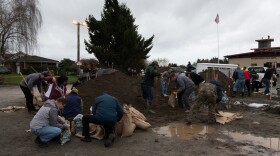Locally grown foods are better for the environment; it takes fewer resources and produces fewer greenhouse gases to get them from farm to table.
And a new report indicates that people in western Washington could pretty easily more than double their consumption of local foods.
Seattle Councilmember Richard Conlin chairs the Regional Food Policy Council for the four western Washington counties surrounding Puget Sound.
“We’re working to try and find ways to get more and better local food to people in western Washington,”Conlin says.
He helped found this regional council two years ago because it was difficult at first to convince his colleagues in city government that growing food in the rural areas surrounding Seattle is important for urban policy work. But Conlin says this issue could have lots of impact.
“Essentially, what good local food can bring to us is better health, more economic development," Conlin says. "The food industry, from farming to processing, to restaurants to grocery stores employs a significant percentage of our population and could employ even more, if we used more local food.”
Meantime, an independent report by the American Farmland Trust indicates that it wouldn’t be that hard to get people here to consume as much as 60% locally-grown foods.
Dennis Canty directs that group’s Pacific Northwest Chapter. He says right now, only about a quarter of the foods we eat here are local.
“The Northwest is one of the best landscapes in the country for growing food. We have a lot of excellent soil; we’ve got an abundance of water. And we feel like we could do a lot better than that one quarter," Cant says.
He says it’s not radical changes that are needed, but relatively simple tweaks to the food system, such as creating more local farmers markets and reducing food waste with innovations in packaging and managing inventory.
“And if all of us just shifted a little bit, to eating that food that’s available locally in season, it would make a really considerable difference,” Canty says.
And at the same time, he says there’s a real danger that as population grows, housing developers will fill in more lots that are suitable for farming. But he thinks consumers can help, by doing things as simple as asking for more local produce at the grocery store... and, maybe letting go of expecting a daily dose of mid-winter tomatoes, from afar.







